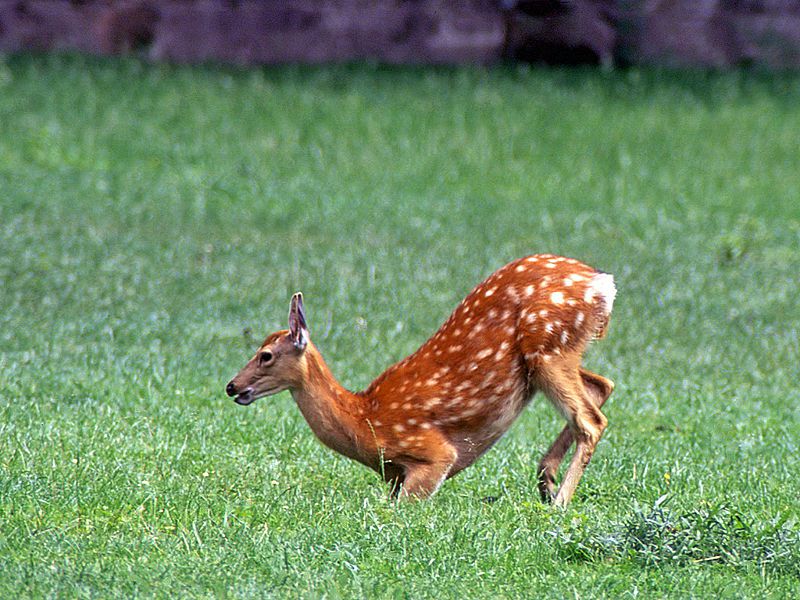-
 Propellant
Propellant
-
 Bacteriostatic
Bacteriostatic
-
 Cuculiformes
Cuculiformes
-
 Common hornbeam
Common hornbeam
-
 Wadsleyite
Wadsleyite
-
 Oscillograph
Oscillograph
-
 Mimosa
Mimosa
-
 BIOS
BIOS
-
 System bus
System bus
-
 DES
DES
-
 Desorption
Desorption
-
 Isoleucine
Isoleucine
-
 Genomics
Genomics
-
 Storage memory
Storage memory
-
 Vickers hardness index
Vickers hardness index
-
 Diplegia
Diplegia
-
 Eclipse
Eclipse
-
 ITS
ITS
-
 Immunotherapy
Immunotherapy
-
 M 37
M 37
-
 Resistivity
Resistivity
-
 CDK
CDK
-
 Grained rock
Grained rock
-
 Dielectric
Dielectric
-
 Gallbladder
Gallbladder
-
 Wallastonite
Wallastonite
-
 Slurry pipeline
Slurry pipeline
-
 Texture
Texture
-
 Systemic antifungal
Systemic antifungal
-
 Scraping
Scraping
Sika deer
Sika deer (Linnaeus 1758) - Cervus nippon
- Order: Artiodactyla
- Family: Cervidae
- Subfamily: Cervinae
- Genus: Cervus
- Size: 1.10 to 1.30 m (height at withers 0.60 to 0.75 m)
- Weight: 35 to 55 kg
- Life span: 15 years
IUCN conservation status; LC least concern
Description of the sika deer
The sika deer is a small ruminant deer with a light brown coat spotted with white patches. In winter its hair turns a darker shade and the patches fade. It has lighter hair around the superciliary arch and a white "mirror" on its rump highlighted by exterior black stripes on the croup. Its very short tail is also white with black stripes. The ventral part is greyish. Morphologically it is a little bit smaller than the fallow deer. It is differentiated by the traditional shape of its antlers which are shed and may grow up to eight tines.

Sika doe. © Jakub Halun, GNU FDL Version 1.2
Habitat of the sika deer
The sika deer is originally from the Far East. It is found in Siberia, China, Korea and Japan. The largest populations are found in the Eastern part of Hokkaido Island in Nara. A few escaped groups breed in regions of France, Switzerland and Central Europe. It prefers mixed and bushy forests and can also settle in coastal areas, in the plains or in Subalpine regions. Individuals were imported to New Zealand and the United States and a few escaped populations have settled.
Behaviour of the sika deer
The sika deer is a little more diurnal than the fallow deer readily ventures out more easily to look for grazing areas. It lives in small herds of a dozen individuals composed of females and yearlings. Males remain in small groups or solitary until the rutting season.

Sika deer with velvety antlers. © Altaileopard, GNU FDL Version 1.2
Sika deer reproduction
The rutting season and deer bellows last from late September through early November. Gestation lasts seven months after which the female gives birth to a single fawn. The fawn is weaned after six months and reaches sexual maturity at 18 to 30 months.

Sika deer juvenile. © Chris 73, GNU FDL Version 1.3
Diet of the sika deer
The sika deer feeds mainly on grasses as well as lichen, mushrooms, leaves, young shoots, wild fruit and even bark in winter.
Threats to the sika deer
The sika deer, which has seven subspecies, was imported to Europe where it has become an invasive species, as it easily crosses with red deer and pollutes its genetic pool. It is not considered to be endangered but its populations are vulnerable due to the expansion of human activity, especially agriculture.
 Photo of a sika deer. © T. Voekler, CCA-S A 3.0 Unported license
Photo of a sika deer. © T. Voekler, CCA-S A 3.0 Unported license
Latest
Fill out my online form.



